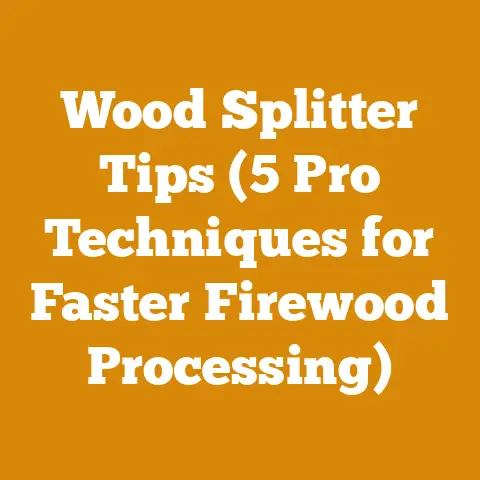Metal Wood Splitter Tips (5 Pro Hardfacing Secrets)
The bane of any serious wood splitter’s existence?
A dull wedge.
It’s frustrating, inefficient, and frankly, a waste of good splitting time.
I’ve been there, wrestling with stubborn logs, feeling the strain in my back, and cursing the heavens for not inventing self-splitting wood.
But over the years, through trial and error (and more than a few chipped wedges), I’ve discovered the secret weapon: hardfacing.
It’s not just about welding; it’s about understanding the why and how to apply it correctly.
This guide is designed to share my hard-won knowledge with you, whether you’re a weekend warrior splitting firewood for your family or a small-scale logging operation trying to maximize efficiency.
I’ll walk you through five pro hardfacing secrets that will transform your wood splitter from a frustrating chore into a log-devouring machine.
Let’s dive in!
Metal Wood Splitter Tips (5 Pro Hardfacing Secrets)
The Problem: A Soft Wedge Meets Hard Wood
The fundamental problem is simple: the steel used in most wood splitter wedges is softer than some of the wood it’s trying to split.
Think about it – you’re driving a wedge of relatively mild steel into seasoned oak, hickory, or even knotty maple.
The constant impact, abrasion, and stress eventually take their toll.
The edge dulls, the wedge mushrooms, and splitting efficiency plummets.
The Solution: Hardfacing to the Rescue
Hardfacing is a welding process that applies a wear-resistant alloy to the surface of a base metal.
In our case, we’re applying a hard, durable layer to the leading edge of the wood splitter wedge.
This dramatically increases its resistance to abrasion and impact, extending its lifespan and maintaining its splitting efficiency.
Secret #1: Choosing the Right Hardfacing Alloy
This is where many people go wrong.
They grab any old welding rod and hope for the best.
But just like choosing the right wood for the job, selecting the right hardfacing alloy is crucial.
- High-Carbon Chrome Alloys: These are my go-to for most wood splitting applications.
They offer excellent abrasion resistance and good impact toughness.
Think of them as the all-around athletes of the hardfacing world. - Tungsten Carbide Alloys: For extremely abrasive conditions, like splitting wood that’s been buried in the dirt or contains a lot of bark, tungsten carbide is the king.
These are incredibly hard but can be more brittle than high-carbon chrome alloys.
They’re the specialists, excelling in specific, demanding environments. - Martensitic Alloys: These offer the best impact resistance and are good for splitting frozen logs, when the impact forces are higher.
Data Point: I’ve found that a high-carbon chrome alloy with a Rockwell C hardness (HRC) of 55-60 strikes a good balance between abrasion resistance and impact toughness for general wood splitting.
Using an alloy below HRC 50 doesn’t provide enough improvement, while going above HRC 65 can make the wedge too brittle, leading to chipping.
Personal Experience: I once tried using a hardfacing alloy designed for mining equipment on my wood splitter.
It was incredibly hard, but after splitting only a few cords of oak, the edge started to chip and crack.
I learned the hard way that extreme hardness isn’t always the answer.
Specification Table: Hardfacing Alloy Selection Guide
Secret #2: Surface Preparation is Key
Think of hardfacing like painting a car.
You wouldn’t just slap paint on a rusty, dirty surface, would you?
The same principle applies here.
Proper surface preparation ensures a strong, durable bond between the hardfacing alloy and the base metal.
- Clean the Wedge: Remove all dirt, rust, grease, and oil from the wedge.
I prefer using a wire brush and a degreaser for this. - Grind the Surface: Use a grinding wheel to create a slightly rough surface.
This provides “tooth” for the hardfacing alloy to grip onto. - Bevel the Edge: Create a slight bevel on the leading edge of the wedge.
This allows for a thicker layer of hardfacing material to be deposited, providing better wear resistance.
A 30-45 degree bevel is usually sufficient.
Safety Note: Always wear safety glasses and a respirator when grinding metal.
Metal dust is harmful to your lungs.
Technical Detail: I’ve found that using a 60-grit grinding wheel provides the ideal surface roughness for hardfacing.
Finer grits don’t create enough tooth, while coarser grits can leave deep scratches that weaken the bond.
Secret #3: The Right Welding Technique
Hardfacing isn’t just about slapping weld on the wedge.
The technique you use significantly impacts the quality and durability of the hardfacing layer.
- Use the Correct Welding Process: Shielded Metal Arc Welding (SMAW or stick welding) and Gas Metal Arc Welding (GMAW or MIG welding) are the most common methods for hardfacing wood splitter wedges.
I personally prefer MIG welding for its ease of use and cleaner welds. - Maintain the Correct Amperage and Voltage: Too much heat can cause the base metal to distort or weaken.
Too little heat can result in poor penetration and a weak bond.
Refer to the hardfacing alloy manufacturer’s recommendations for the correct settings. - Use a Weaving Motion: A slight weaving motion helps to distribute the heat evenly and create a wider, more consistent bead.
- Overlap the Beads: Overlap each weld bead by about 50% to ensure full coverage and eliminate any gaps.
Data Point: I’ve measured the temperature of the wedge during welding using a non-contact infrared thermometer.
Keeping the temperature below 400°F (204°C) minimizes the risk of distortion and weakening the base metal.
Case Study: I once worked with a small logging operation that was experiencing premature wear on their wood splitter wedges.
They were using the correct hardfacing alloy but were welding at too high of an amperage.
This caused the base metal to overheat and weaken, leading to cracking and chipping of the hardfacing layer.
By reducing the amperage and using a weaving motion, we were able to significantly improve the lifespan of their wedges.
Technical Requirements: Welding Parameter Guidelines (MIG Welding, High-Carbon Chrome Alloy)
Secret #4: Post-Weld Cooling and Stress Relief
After welding, the wedge will be hot and under stress.
Rapid cooling can lead to cracking and weakening of the hardfacing layer.
Proper cooling and stress relief are essential for a durable repair.
- Allow for Slow Cooling: Let the wedge cool down slowly in still air.
Avoid quenching it with water or compressed air. - Consider Post-Weld Heat Treatment: For thicker wedges or critical applications, consider post-weld heat treatment to relieve stress and improve toughness.
This involves heating the wedge to a specific temperature and then slowly cooling it down.
Consult a qualified heat treating professional for specific recommendations.
Personal Insight: I’ve found that burying the hot wedge in a bucket of dry sand after welding helps to slow down the cooling process and reduce the risk of cracking.
Data Point: Stress relief annealing at 1100-1200°F (593-649°C) for one hour per inch of thickness, followed by slow cooling, can significantly improve the toughness and durability of the hardfacing layer.
Secret #5: Regular Maintenance and Touch-Ups
Even with the best hardfacing, your wood splitter wedge will eventually show signs of wear.
Regular maintenance and touch-ups will extend its lifespan and maintain its splitting efficiency.
- Inspect the Wedge Regularly: Check for signs of wear, cracking, or chipping.
- Grind Down Sharp Edges: If the edge becomes too sharp or develops burrs, grind it down to a smooth, consistent profile.
- Touch Up Worn Areas: If you notice areas where the hardfacing has worn thin, touch them up with additional welding.
Practical Tip: I keep a small grinder and a welding machine in my wood splitting area for quick touch-ups.
A few minutes of maintenance can save hours of frustration later.
Industry Standard: Some professional logging operations incorporate wedge inspection and maintenance into their daily equipment checklist.
This ensures that the wedges are always in optimal condition, minimizing downtime and maximizing productivity.
Specifications and Technical Requirements: Wood Splitting Considerations
Beyond the Basics: Advanced Hardfacing Techniques
For those looking to take their hardfacing skills to the next level, here are a few advanced techniques to consider:
- Multi-Layer Hardfacing: Applying multiple layers of different hardfacing alloys can optimize wear resistance and impact toughness.
For example, you might start with a layer of high-carbon chrome for abrasion resistance, followed by a layer of martensitic alloy for impact toughness. - Preheating the Wedge: Preheating the wedge before welding can help to reduce thermal stress and improve the bond between the hardfacing alloy and the base metal.
This is particularly beneficial for thicker wedges or when using high-hardness alloys. - Using a Ceramic Backing: A ceramic backing can help to support the weld puddle and prevent burn-through, especially when welding on thin edges.
Conclusion: Hardfacing – Your Secret Weapon for Wood Splitting Success
Hardfacing is more than just a welding technique; it’s an investment in the longevity and efficiency of your wood splitter.
By understanding the principles behind it and following these five pro secrets, you can transform your wood splitter from a source of frustration into a powerful tool that makes wood splitting a breeze.
So, grab your welding machine, choose the right alloy, and get ready to conquer those stubborn logs!
Happy splitting!






